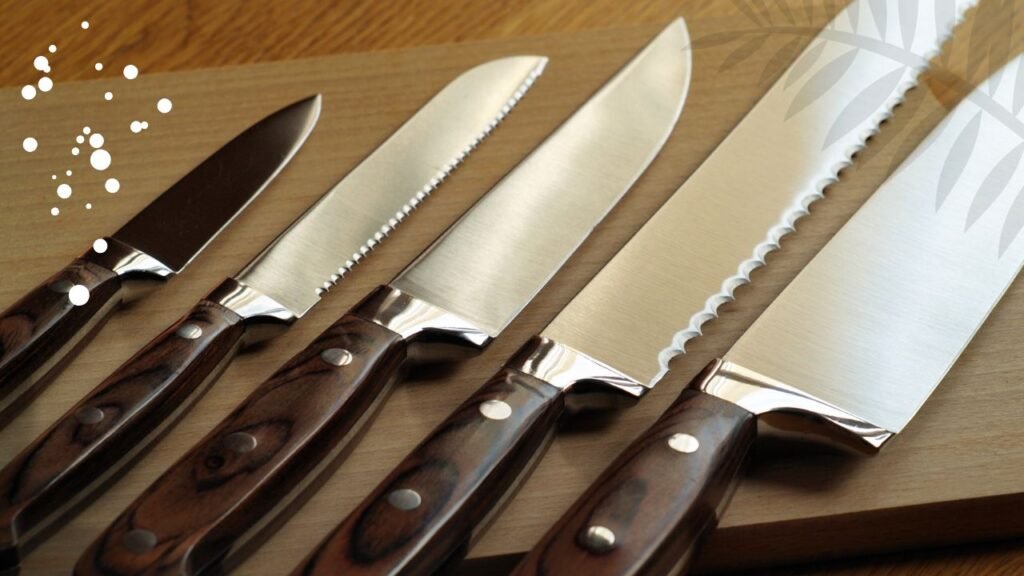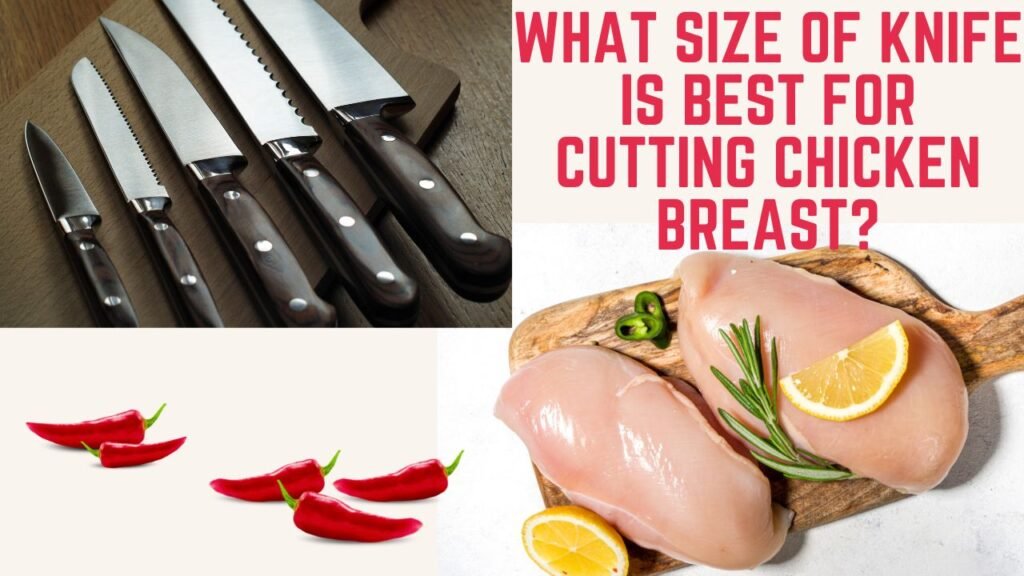Imagine this: You’re preparing a delicious chicken dinner, but as you reach for your knife, you realize it’s not quite up to the task. The slices are uneven, the meat tears instead of gliding smoothly, and your frustration begins to mount. Ever wondered why some cuts of chicken look restaurant-perfect while others resemble a messy ordeal? The secret often lies in what size of knife is best for cutting chicken breast. Whether you’re a seasoned chef or a kitchen novice, choosing the right knife can transform your cooking experience, ensuring both safety and culinary excellence. Let’s dive into everything you need to know about selecting the perfect knife size for cutting chicken breast.
Why Choosing the Right Knife Size Matters
Have you ever struggled to carve a chicken breast, only to end up with uneven slices and a mess on your cutting board? The size of your knife plays a crucial role in the precision and ease of cutting chicken breast. A properly sized knife not only makes the task easier but also enhances safety and the overall quality of your meal.
Key Benefits of the Right Knife Size:
- Precision Cutting: Achieve uniform slices that cook evenly.
- Safety: A well-sized knife reduces the risk of slipping and accidental cuts.
- Efficiency: Complete your tasks faster with the right tool in hand.
- Enhanced Presentation: Neatly sliced chicken breasts elevate the look of your dishes.
Types of Knives Suitable for Cutting Chicken Breast
When determining what size of knife is best for cutting chicken breast, it’s essential to consider the various types of knives available and their specific advantages.
Chef’s Knife
A chef’s knife is a versatile tool found in almost every kitchen. Known for its broad blade and sharp edge, it’s ideal for a wide range of tasks, including cutting chicken breast.
- Blade Length: Typically 8 to 10 inches.
- Advantages: Excellent balance, versatile use, precise control.
- Personal Opinion: I find a well-balanced chef’s knife indispensable. Its ability to handle everything from slicing chicken breast to chopping vegetables makes it a kitchen staple.
Santoku Knife
Originating from Japan, the Santoku knife is another popular choice for cutting chicken breast. It combines the functionality of a chef’s knife with a slightly different design.
- Blade Length: Usually 6 to 7 inches.
- Advantages: Lightweight, sharp edge, excellent for slicing and dicing.
- Personal Opinion: The Santoku knife’s versatility and ease of handling make it a fantastic alternative to the traditional chef’s knife, especially for those who prefer a lighter tool.
Utility Knife
A utility knife serves as a middle ground between a chef’s knife and a paring knife, offering a balance of size and functionality.
- Blade Length: Typically 4 to 7 inches.
- Advantages: Maneuverable, precise cuts, versatile for various tasks.
- Personal Opinion: For detailed work, such as trimming and portioning chicken breast, a utility knife is perfect. Its manageable size makes it easier to handle intricate cuts.
Boning Knife
While not always the first choice for cutting chicken breast, a boning knife can be incredibly effective, especially when working with bone-in pieces.
- Blade Length: Generally 5 to 6 inches.
- Advantages: Thin, flexible blade ideal for navigating around bones and joints.
- Personal Opinion: If you frequently work with bone-in chicken, a boning knife is a must-have. Its precision and flexibility make separating meat from bones a breeze.
Comparing Knife Types
Choosing the right knife involves understanding the strengths and weaknesses of each type. If you want’s to know what size of knife is best for cutting chicken breast, here’s a quick comparison to help you decide:
| Knife Type | Blade Length | Pros | Cons |
|---|---|---|---|
| Chef’s Knife | 8-10 inches | Versatile, precise, excellent control | Can be bulky for small tasks |
| Santoku Knife | 6-7 inches | Lightweight, sharp, great for slicing | Less suitable for heavy-duty tasks |
| Utility Knife | 4-7 inches | Maneuverable, precise, versatile | Not as specialized as other knives |
| Boning Knife | 5-6 inches | Flexible, precise around bones | Limited use outside meat preparation |

What Size Knife is Best for Cutting Chicken Breast?
When it comes to what size of knife is best for cutting chicken breast, the general consensus leans towards a chef’s knife with a blade length of 8 to 10 inches. This size offers the perfect balance between versatility and control, making it ideal for slicing, dicing, and portioning chicken breast with ease.
Why 8 to 10 Inches?
- Optimal Length: Provides ample cutting surface for smooth, continuous slices.
- Control and Precision: Longer blades offer better control, allowing for precise cuts without excessive force.
- Versatility: Suitable for a variety of tasks beyond just cutting chicken, enhancing overall kitchen efficiency.
Smaller Knives: When They Work Best
While an 8 to 10-inch chef’s knife is ideal for most tasks, smaller knives like the Santoku or utility knife can be beneficial for more detailed work.
- 6 to 7 Inches (Santoku): Perfect for slicing chicken breast into even, thin pieces.
- 4 to 7 Inches (Utility): Great for trimming and portioning, especially in confined spaces.
Features to Consider Beyond Size
While the size of the knife is crucial, other features can significantly impact your chicken cutting experience.
Blade Shape and Flexibility
The shape and flexibility of the blade influence how easily you can maneuver around bones and joints.
- Curved Blade: Facilitates a rocking motion for smoother cuts.
- Straight Blade: Ideal for making precise, straight slices.
- Flexibility: A slightly flexible blade helps in navigating around bones without tearing the meat.
Handle Comfort and Grip
A comfortable handle ensures better control and reduces fatigue during prolonged use.
- Ergonomic Design: Fits comfortably in your hand, providing a secure grip.
- Non-Slip Grip: Essential for maintaining control, especially when handling raw chicken.
Blade Material and Durability
The material of the blade affects its sharpness, durability, and ease of maintenance.
- High-Carbon Stainless Steel: Offers excellent sharpness and resistance to rust.
- Stainless Steel: Durable and easy to maintain, though may require more frequent sharpening.
Maintenance and Care
Proper maintenance ensures your knife remains sharp and safe for use.
- Regular Sharpening: Keeps the blade in optimal condition for precise cuts.
- Proper Cleaning: Hand wash and dry immediately to prevent rust and corrosion.
How to Choose the Right Knife for You
Selecting the right knife involves considering your cooking style, frequency of use, and personal preferences.
Assess Your Cooking Needs
- Frequency: If you cook chicken breast regularly, investing in a high-quality chef’s knife or boning knife is worthwhile.
- Cooking Style: For those who enjoy precise slicing and detailed work, a Santoku or utility knife might be more suitable.
Budget Considerations
- Quality vs. Cost: While high-quality knives can be more expensive, they offer better performance and longevity.
- Investment: Consider knives as long-term investments. A good knife can last a lifetime with proper care.
Personal Preferences
- Grip and Weight: Choose a knife that feels comfortable in your hand, with a balance between weight and control.
- Aesthetics: While functionality is paramount, a knife that appeals to you aesthetically can enhance your cooking experience.
Tips for Cutting Chicken Breast Effectively
Mastering how can I safely cut raw chicken with a knife goes beyond just choosing the right knife. Here are some tips to enhance your cutting technique:
Keep Your Knife Sharp
A sharp knife is safer and more efficient, reducing the risk of slipping and ensuring clean cuts.
- Regular Sharpening: Use a honing steel or sharpening tool to maintain the edge.
- Proper Storage: Store knives properly to prevent dulling.
Use Proper Cutting Techniques
Employing the right techniques can make the process smoother and safer.
- Stable Grip: Hold the knife firmly with your dominant hand and use a claw grip with your non-dominant hand to guide the chicken.
- Controlled Motion: Use smooth, steady cuts rather than jerky or forceful motions.
- Cut Against the Grain: Slicing against the grain ensures more tender slices.
Maintain a Clean Workspace
A tidy workspace reduces the risk of accidents and cross-contamination.
- Sanitize Surfaces: Clean your cutting board and knives before and after use.
- Organize Tools: Keep all necessary tools within reach to avoid unnecessary movements.
Personal Tips
- Pat Dry the Chicken: Removing excess moisture helps in achieving cleaner cuts and better knife control.
- Slice Evenly: Aim for uniform thickness to ensure even cooking.
Common Mistakes to Avoid
Even with the best tools and techniques, certain mistakes can compromise safety and the quality of your cuts. Here are some common pitfalls and how to avoid them:
Using a Dull Knife
A dull knife can slip, causing injuries and making it harder to achieve clean cuts.
- Solution: Regularly sharpen your knife and replace it if it loses its edge.
Cutting Too Quickly
Rushing increases the risk of accidents and leads to uneven slices.
- Solution: Take your time and use controlled, steady motions.
Not Securing the Cutting Board
An unstable cutting board can lead to slips and accidents.
- Solution: Place a damp towel underneath the cutting board to keep it steady.
Ignoring Hand Positioning
Improper hand positioning can result in cuts and injuries.
- Solution: Use the claw grip with your non-dominant hand to guide the chicken safely.
Cross-
Contamination
Allowing raw chicken juices to come into contact with other foods can spread harmful bacteria.
- Solution: Use separate cutting boards and utensils for raw chicken and other ingredients. Always wash your hands and tools thoroughly after handling raw meat.
Comparing Knife Types for Cutting Chicken Breast
Choosing the right knife involves understanding the strengths and weaknesses of each type. Here’s a quick comparison to help you decide what size of knife is best for cutting chicken breast:
| Knife Type | Blade Length | Pros | Cons |
|---|---|---|---|
| Chef’s Knife | 8-10 inches | Versatile, excellent control and precision | Can be bulky for small tasks |
| Santoku Knife | 6-7 inches | Lightweight, sharp, great for slicing | Less suitable for heavy-duty tasks |
| Utility Knife | 4-7 inches | Maneuverable, precise, versatile | Not as specialized as other knives |
| Boning Knife | 5-6 inches | Flexible, precise around bones | Limited use outside meat preparation |
Personal Opinion:
While a chef’s knife is my go-to for most tasks, a boning knife is indispensable when dealing with bones and joints in chicken breast. Having a variety of knives ensures you’re prepared for any cutting challenge.

Delicious Recipes You Can Make with Properly Cut Chicken Breast
Once you’ve mastered how can I safely cut raw chicken with a knife, it’s time to put those skills to good use with some mouth-watering recipes.
1. Grilled Lemon Herb Chicken Breast
A fresh and zesty dish perfect for summer evenings.
Ingredients:
- 2 chicken breasts, cut into strips
- 3 tbsp olive oil
- 2 lemons, juiced and zested
- 3 cloves garlic, minced
- 2 tbsp fresh rosemary, chopped
- Salt and pepper to taste
Instructions:
- Prepare Marinade: In a bowl, combine olive oil, lemon juice and zest, garlic, rosemary, salt, and pepper.
- Marinate Chicken: Add the chicken strips to the marinade, ensuring they are well-coated. Let sit for at least 30 minutes.
- Preheat Grill: Heat your grill to medium-high.
- Grill Chicken: Place the chicken strips on the grill and cook for 6-7 minutes per side, or until the internal temperature reaches 165°F.
- Serve: Garnish with additional lemon slices and fresh herbs. Serve with grilled vegetables or a fresh salad.
2. Chicken Stir-Fry with Vegetables
A quick and healthy meal packed with flavor and nutrients.
Ingredients:
- 2 chicken breasts, sliced into thin strips
- 2 tbsp soy sauce
- 1 tbsp oyster sauce
- 1 tsp cornstarch
- 2 tbsp vegetable oil
- 1 bell pepper, sliced
- 1 carrot, julienned
- 1 cup broccoli florets
- 2 cloves garlic, minced
- 1 tsp ginger, grated
- Cooked rice or noodles
Instructions:
- Marinate Chicken: In a bowl, mix soy sauce, oyster sauce, and cornstarch. Add chicken strips and marinate for 15 minutes.
- Cook Chicken: Heat vegetable oil in a large skillet or wok over high heat. Add chicken and stir-fry until browned and cooked through, about 5-7 minutes. Remove and set aside.
- Stir-Fry Vegetables: In the same skillet, add a bit more oil if needed. Add bell pepper, carrot, and broccoli. Stir-fry for 3-4 minutes until tender-crisp.
- Add Aromatics: Add garlic and ginger, sautéing for another minute.
- Combine: Return the chicken to the skillet and toss everything together. Cook for an additional 2 minutes.
- Serve: Serve hot over cooked rice or noodles.
Quick Recipe Ideas
| Recipe | Main Ingredients | Preparation Time | Difficulty |
|---|---|---|---|
| Grilled Lemon Herb Chicken | Chicken breasts, lemons, rosemary | 40 minutes | Easy |
| Chicken Stir-Fry | Chicken breasts, mixed vegetables, soy sauce | 25 minutes | Easy |
| Chicken Alfredo Pasta | Chicken breasts, heavy cream, Parmesan | 30 minutes | Medium |
| Chicken Tacos | Sliced chicken breast, tortillas, toppings | 15 minutes | Easy |
Frequently Asked Questions
1. Can I use any type of knife to cut chicken breast safely?
While various knives can be used, a sharp chef’s knife or boning knife is recommended for precision and safety. These knives offer better control and make the cutting process smoother.
2. How do I prevent my knife from slipping while cutting chicken breast?
Ensure your knife is sharp and handle it with a firm grip. Stabilize the chicken on a secure cutting board and use a claw grip with your non-dominant hand to guide the meat safely.
3. What should I do if I accidentally cut myself while handling raw chicken?
Immediately wash the wound with soap and water, apply an antiseptic, and cover it with a clean bandage. Seek medical attention if the cut is deep or if you notice signs of infection.
4. How can I ensure my chicken breast is fully cooked after cutting?
Use a meat thermometer to check the internal temperature, ensuring it reaches at least 165°F (74°C). Alternatively, cut into the thickest part of the meat to ensure the juices run clear.
5. Is it safe to reuse the same knife for raw chicken and other foods?
No, reusing the same knife can lead to cross-contamination. Always thoroughly wash and sanitize knives and cutting boards after handling raw chicken before using them for other foods.
Conclusion
Mastering what size of knife is best for cutting chicken breast is an essential skill that enhances both your cooking efficiency and kitchen safety. By choosing the right knife, following proper techniques, and adhering to safety measures, you can prepare delicious and safe meals with confidence. Remember to keep your tools sharp, maintain a clean workspace, and handle raw chicken with care to prevent cross-contamination. Whether you’re preparing a simple weeknight dinner or a festive feast, these tips will ensure your chicken dishes are both delicious and safe to enjoy. So, grab your favorite knife, follow these steps, and carve your way to culinary success!


